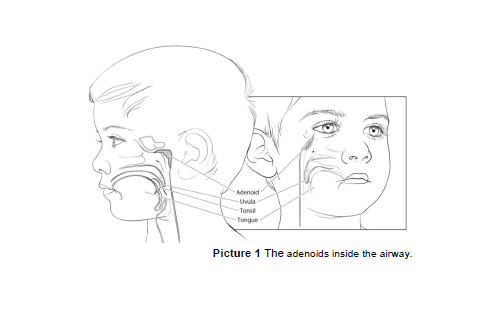Adenoid Removal (Adenoidectomy)

Adenoids (ADD en oyds) are glands high in the throat behind the nose (Picture 1). Surgery to remove the adenoids is called an adenoidectomy (ADD en oyd ECT oh mee). An adenoidectomy may be done if your child has trouble with breathing through the nose or for problems with frequent ear infections or sinus infections, among other reasons. Often, the adenoids shrink as children reach their teens. An adenoidectomy may be done as its own surgery or it may be done at the same time as a tonsillectomy or other procedures.

Why Surgery May Be Needed
Your child’s doctor may suggest that the adenoids be removed if:
- The adenoids are enlarged and are blocking the nose. Signs of a blocked airway include snoring, trouble breathing through the nose, breathing with the mouth open or times when the child stops breathing during sleep (sleep apnea).
- Your child is having repeated ear infections (3 ear infections in 6 months or 4 ear infections in 12 months) or there is fluid in the ears that does not clear on its own.
- Your child is having repeated sinus infections.
Before the Surgery
- The nurse will call you to ask you questions about your child’s health.
- The nurse will tell you when to stop giving your child food and liquids, when to get to the hospital and the time of the surgery.
- Gum, cough drops and hard candy are not allowed. If your child has been chewing gum, surgery will be delayed 2 hours from the time the gum is spit out. If the gum has been swallowed, surgery will be delayed 6 hours from the time it was swallowed.
NOTE: Surgery may be cancelled if these guidelines are not followed.
The Day of Surgery
- Bring these things with you:
- Your child’s medical insurance information and your photo ID.
- List of all the medicines your child is taking.
- A few of your child’s favorite toys with their name written on them. Your child will also get a toy to keep.
- Your child will have a medical exam. They will also be weighed, measured and have their temperature and blood pressure taken.
- You will talk to the doctor who gives the medicine to make your child sleep during the surgery. This doctor is called an anesthesiologist. You will also speak to the doctor performing the surgery.
- The nurse will explain routines, procedures and home care.
- Your child will be asleep through the surgery and not feel pain. The surgeon will remove extra adenoid tissue. The surgery usually lasts 20 to 30 minutes.
- Your child will stay in the recovery room until they are awake and can breathe easily, cough and swallow. Many children can go home an hour or two after this surgery. Complete recovery takes about 1 to 2 weeks. In rare cases, adenoid tissue that has been removed may grow back.
Care at Home
- For 7 to 10 days after surgery it is normal if your child has:
- A stuffy nose and snoring
- Low-grade fever of 100 degrees F to 101 degrees F. (37.7 to 38.3 degrees C).
- Bad breath
- Thick nose drainage
- For the first 2 hours after surgery, you may give clear liquids, like7-Up®, Popsicles® and apple juice. Your child may have solid foods if he handles the fluids well.
- Give your child acetaminophen (Tylenol®) or ibuprofen (Motrin®, Advil®) if they have pain, a sore throat or headache. The child can return to normal activities as soon as they feel like it. Your child may go back to school or daycare in 2 to 3 days.
When to Call the Doctor
Call the doctor if:
- Your child’s temperature is higher than 101 degrees F (38.3 degrees C).
- Drainage from your child’s nose lasts longer than 14 days.
- Your child has signs of dehydration, like dry mouth, sunken look around his eyes, no tears when crying or reduced amount of pee (urine).
- There is any bleeding from the mouth or nose after the surgery.
Follow-up
Generally, children do well after surgery. You will get a follow-up phone call from a nurse 4 to 6 weeks after the surgery. If there are any concerns, an office visit will be scheduled.
If you have any questions, be sure to call the ENT Nurse Line at (614) 722-6547 and ask your child’s health care provider.
HH-I-307 ©2011, Revised 2021, Nationwide Children’s Hospital
